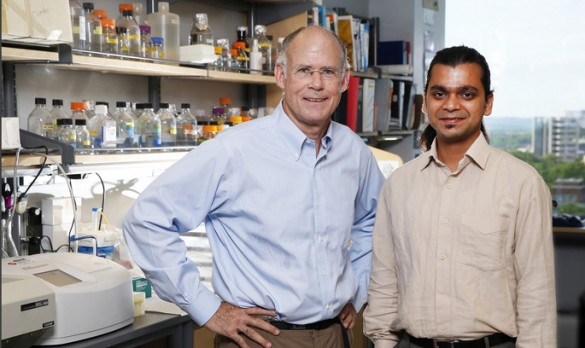
Researchers at Vanderbilt University Medical Center led by a 32-year-old postdoctoral fellow have discovered a new mechanism for the development of cancer that is challenging conventional scientific wisdom.
Bhuminder Singh, Ph.D., is first author of a paper describing how “mistrafficking” of a ligand, a protein that binds to the EGF receptor, can “transform” epithelial cells into a particularly vicious tumor in mice.
The report, published last week in the Proceedings of the National Academy of Sciences, is the first to demonstrate transformation of polarized epithelial cells by mistrafficking of an EGF receptor ligand called epiregulin to the cell’s outer, “apical” surface.
This is complicated stuff, to be sure. But for Singh and his mentor, Robert Coffey, M.D., Ingram Professor of Cancer Research, who is internationally known for his work on EGF receptor signaling, it’s like striking the mother lode.
Mutations that would cause mistrafficking of epiregulin have been found in human tumors, Singh said. This supports the relevance of this work to the 90 percent of human cancers that arise from epithelial cells.
The paper’s co-authors were senior research specialist Galina Bogatcheva and Mary Kay Washington, M.D., Ph.D., professor of Pathology, Microbiology and Immunology.
The story of Singh’s achievement actually begins 60 years ago with the discovery of epidermal growth factor (EGF), a protein important in tissue growth, by Nobel laureate and retired Vanderbilt professor Stanley Cohen, Ph.D.
EGF is not the only protein that binds to and activates the EGF receptor. There are actually seven different EGF receptor ligands, each of which has its own purpose in specific tissues at different times during development.
The EGF receptor is thus a multipurpose signaling “switch.”
Coffey, who also is professor of Medicine and Cell & Developmental Biology and director of the Epithelial Biology Center, has spent the better part of 20 years figuring out what different EGF receptor ligands do in the epithelial cells that line the gastrointestinal (GI) tract.
Singh, a native of India who earned his Ph.D. under Axel Ullrich, Ph.D., at the Max Planck Institute for Biochemistry in Munich, Germany, said he chose the Coffey lab in 2007 for his postdoctoral work because it’s the only place in the world where this kind of work is being done.
Epithelial cells are “polarized,” meaning that they have one “apical” surface that faces the lumen, or body cavities, lateral sides and a “basal,” or bottom side. The basal and lateral, or basolateral, sides face inward, toward other cells, the blood or supportive tissue.
Most EGF receptors are located on the basolateral surfaces of epithelial cells. But about 5 percent to 10 percent are also found on the apical surface.
Conventional scientific wisdom has held that these receptors don’t serve any important function. The Vanderbilt researchers weren’t so sure.
In this study, they focused on epiregulin, which normally is expressed in low levels in normal epithelia. But when the epiregulin gene is overexpressed along with three other genes, cancer cells in the breast can break free and move, or metastasize, to the lung.
Does epiregulin play a role in other cancers, too?
To answer that question, the researchers turned their attention to the ligand’s cytoplasmic “tail,” the specific sequence of amino acids that acts like a bar code – telling the cell where the ligand should be “delivered.”
In the kidney, for example, a rare, inherited genetic mutation that changes the EGF “barcode” prevents it from being delivered to and activating the correct EGF receptor. That, in turn, blocks the kidney from absorbing magnesium, and causes a potentially life-threatening condition.
What would happen in polarized epithelial cells if epiregulin’s barcode was altered?
Singh found, that by switching a single amino acid, he could redirect – “mistraffic” — epiregulin from its normal basolateral destination to the apical surface. When, in a mouse model, epiregulin bound with the small number of EGF receptors there, it triggered massive transformation – cancer.
“Previously if you would have seen this mutation, you would say that it’s inconsequential,” Singh said. “But our study tells you that location of ligands in the cell is crucial … if you get rid of that information, like these human cancer mutations do … all hell breaks loose.”
The research was supported by National Institutes of Health grants CA046413 and CA095103.












